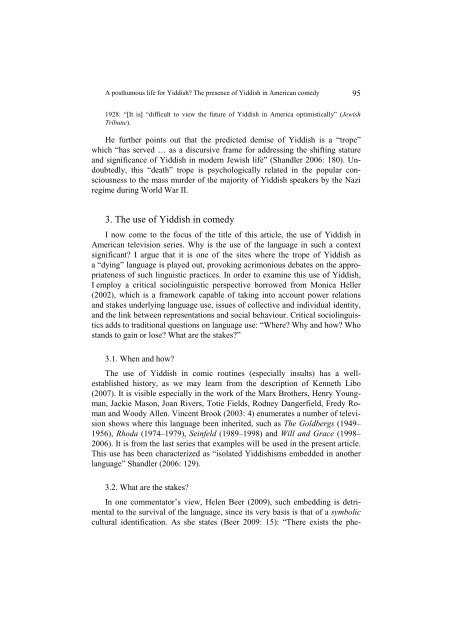s - Wyższa SzkoÅa Filologiczna we WrocÅawiu
s - Wyższa SzkoÅa Filologiczna we WrocÅawiu
s - Wyższa SzkoÅa Filologiczna we WrocÅawiu
Create successful ePaper yourself
Turn your PDF publications into a flip-book with our unique Google optimized e-Paper software.
A posthumous life for Yiddish? The presence of Yiddish in American comedy 95<br />
1928: “[It is] “difficult to view the future of Yiddish in America optimistically” (Jewish<br />
Tribune).<br />
He further points out that the predicted demise of Yiddish is a “trope”<br />
which “has served … as a discursive frame for addressing the shifting stature<br />
and significance of Yiddish in modern Jewish life” (Shandler 2006: 180). Undoubtedly,<br />
this “death” trope is psychologically related in the popular consciousness<br />
to the mass murder of the majority of Yiddish speakers by the Nazi<br />
regime during World War II.<br />
3. The use of Yiddish in comedy<br />
I now come to the focus of the title of this article, the use of Yiddish in<br />
American television series. Why is the use of the language in such a context<br />
significant? I argue that it is one of the sites where the trope of Yiddish as<br />
a “dying” language is played out, provoking acrimonious debates on the appropriateness<br />
of such linguistic practices. In order to examine this use of Yiddish,<br />
I employ a critical sociolinguistic perspective borro<strong>we</strong>d from Monica Heller<br />
(2002), which is a framework capable of taking into account po<strong>we</strong>r relations<br />
and stakes underlying language use, issues of collective and individual identity,<br />
and the link bet<strong>we</strong>en representations and social behaviour. Critical sociolinguistics<br />
adds to traditional questions on language use: “Where? Why and how? Who<br />
stands to gain or lose? What are the stakes?”<br />
3.1. When and how?<br />
The use of Yiddish in comic routines (especially insults) has a <strong>we</strong>llestablished<br />
history, as <strong>we</strong> may learn from the description of Kenneth Libo<br />
(2007). It is visible especially in the work of the Marx Brothers, Henry Youngman,<br />
Jackie Mason, Joan Rivers, Totie Fields, Rodney Dangerfield, Fredy Roman<br />
and Woody Allen. Vincent Brook (2003: 4) enumerates a number of television<br />
shows where this language been inherited, such as The Goldbergs (1949–<br />
1956), Rhoda (1974–1979), Seinfeld (1989–1998) and Will and Grace (1998–<br />
2006). It is from the last series that examples will be used in the present article.<br />
This use has been characterized as “isolated Yiddishisms embedded in another<br />
language” Shandler (2006: 129).<br />
3.2. What are the stakes?<br />
In one commentator’s view, Helen Beer (2009), such embedding is detrimental<br />
to the survival of the language, since its very basis is that of a symbolic<br />
cultural identification. As she states (Beer 2009: 15): “There exists the phe-
















